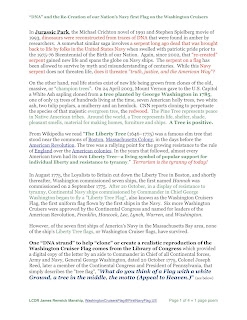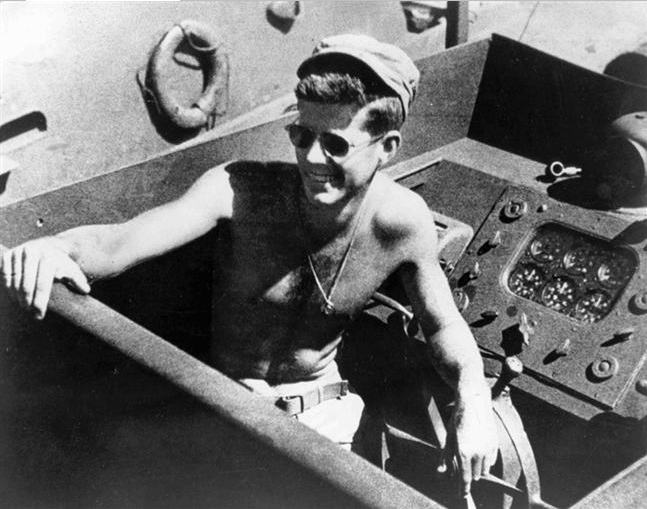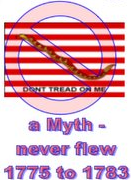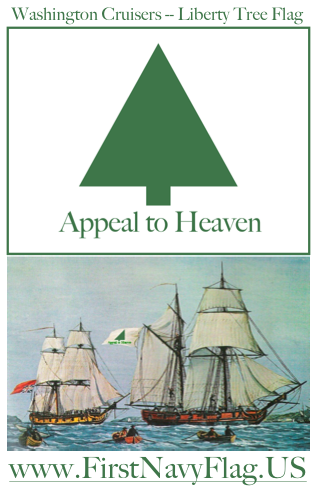Friday, July 04, 2008
First Navy Flag "pattern" and "DNA" bits of History supporting replica design or "Re-Creation"
Posted by
"George Washington" 'States'Manship
at
Friday, July 04, 2008
1 comments
![]()
![]()
Liberty Tree Flag in 4th of July Parade in Washington, DC & many others
In 2008 Independence Day Parade is the first time the First Navy Flag, Liberty Tree Flag (re-created) flew as its bearer marched in the parade. A few weeks later the Washington Cruiser Flag flew in front of the Statue of Washington in the U.S. Capitol Rotunda...
It flew again in the Labor Day Parade in Buena Vista, Virginia, the Governor Jefferson Thanksgiving Parade in Charlottesville (the Saturday before Thanksgiving), the Macy's Thanksgiving Day Parade in New York City, and later at the Federal Building on Wall Street.
Later that year after Christmas, the flag traveled to the Birthplace of the American Navy to Marblehead, Massachusett where it "flew" in front of the original "Spirit of '76" painting.
The Washington Cruisers "Appeal to Heaven" Flag also flew on the pier in front of the USS Constitution, in front of the Massachusetts Capitol on Beacon Hill in Boston, and in Trinity Church, Newport, Rhode Island where General Washington attended prayer services when in Newport, a few blocks from Washington Square.
Posted by
"George Washington" 'States'Manship
at
Friday, July 04, 2008
0
comments
![]()
![]()
Saturday, February 09, 2008
8Feb2008Ltr_PresidentBush
Posted by
"George Washington" 'States'Manship
at
Saturday, February 09, 2008
0
comments
![]()
![]()
"Fake Snake" current Navy Jack flag - myth exposed!
Posted by
"George Washington" 'States'Manship
at
Saturday, February 09, 2008
0
comments
![]()
![]()
1stNavyFlag_TwoBitsDNA
Posted by
"George Washington" 'States'Manship
at
Saturday, February 09, 2008
0
comments
![]()
![]()
RebelsUnderSail
Posted by
"George Washington" 'States'Manship
at
Saturday, February 09, 2008
0
comments
![]()
![]()
1stNavyFlagDNAp1
Posted by
"George Washington" 'States'Manship
at
Saturday, February 09, 2008
0
comments
![]()
![]()
1stNavyFlagDNAp2
Posted by
"George Washington" 'States'Manship
at
Saturday, February 09, 2008
0
comments
![]()
![]()
1stNavyFlagDNAp3
Posted by
"George Washington" 'States'Manship
at
Saturday, February 09, 2008
0
comments
![]()
![]()
1stNavyFlagDNAp4
Posted by
"George Washington" 'States'Manship
at
Saturday, February 09, 2008
0
comments
![]()
![]()
1stNavyFlagDNAp5 Paine Poem - LIBERTY TREE
Posted by
"George Washington" 'States'Manship
at
Saturday, February 09, 2008
0
comments
![]()
![]()
NHF_LoC_Laube_FirstNavyFlag
Posted by
"George Washington" 'States'Manship
at
Saturday, February 09, 2008
0
comments
![]()
![]()
8Feb2008Ltr_Bill_Middendorf
Posted by
"George Washington" 'States'Manship
at
Saturday, February 09, 2008
0
comments
![]()
![]()
8Feb2008Ltr_Amb_Middendorf
Posted by
"George Washington" 'States'Manship
at
Saturday, February 09, 2008
0
comments
![]()
![]()
4Feb2008Ltr_AmbMiddendorf
Posted by
"George Washington" 'States'Manship
at
Saturday, February 09, 2008
0
comments
![]()
![]()
6Jan2006Ltr_SECNAV_Winter
Posted by
"George Washington" 'States'Manship
at
Saturday, February 09, 2008
0
comments
![]()
![]()
18Jan2008Ltr_FirstLadyB
Posted by
"George Washington" 'States'Manship
at
Saturday, February 09, 2008
0
comments
![]()
![]()
18Jan2008Ltr_FirstLady_GWinClassrooms
Posted by
"George Washington" 'States'Manship
at
Saturday, February 09, 2008
0
comments
![]()
![]()
Saturday, February 02, 2008
Updated America-England descriptions of First Navy Flag
Posted by
"George Washington" 'States'Manship
at
Saturday, February 02, 2008
0
comments
![]()
![]()
Naval Historical Foundation book "The NAVY" shows first ship Hannah with Liberty Tree Flag
Posted by
"George Washington" 'States'Manship
at
Saturday, February 02, 2008
0
comments
![]()
![]()
12th Revision, (maybe "Final") of "DNA and re-creation of First Navy Flag" article
Dear Gary,
I have made a few additions, including your black and white diagram of the Connecticut 5th Regiment "Pine Tree" flag from the Flag Bulletin #206.
Put it on the right side of the quote from your other article with David Martucci, yet had to reduce the font size to make everything fit.
Also added to images of paintings of the first Continental Navy ship, Hannah, and another of the Washington Cruisers, the Continental Navy ship Lee.
The Continental Navy ship Lee picture was mailed to me by an aide to the former Secretary of the Navy Gordon England about the time he was named Deputy Secretary of Defense.
The first Navy ship Hannah picture is from the big "coffee table" book "The NAVY" published by the Naval Historical Foundation.
I learned from reading James Fenimore Cooper's History of the Navy that a "Providence packet" ship named "Hannah" eluding the British ship Gaspe' was able to cause the British ship with a deeper draft to run aground on a sand bar the Hannah knew about and was able to sail over due to its more shallow draft. Really clever!
Later the marooned Gaspe' exploded, presumably by other Patriot attacks, so that was an early Navy "victory" for the Americans.
That probably happened pretty close to where you live. Do you know of that Hannah-Gaspe' "battle"?
I am very curious if that "Hannah" might by some stroke of good fortune also be the Hannah of Colonel John Glover, that became America's first ship commissioned in the Continental Navy according to the big "coffee table" book "The NAVY" published by the Naval Historical Foundation.
Both ships were from or commissioned in Marblehead, so I believe the Continental ship Lee was most likely named for Jeremiah Lee of Marblehead who died on 10 May 1775 from injuries sustained on 19 April, the same day as the Battle of Lexington and Concord when the
British also tried to capture Jeremiah Lee, John Hancock and Samuel Adams, who were the organizers of the "Rebels", or chief rabble rousers.
Those "Marvelous Men of Marblehead" were key to the survival of our Continental Army at Brooklyn Heights at the other end of Long Island from you, the "Dunkirk" of the Revolution, and were critical to the successful "Washington Crossing", the Inchon Landing of the
Revolution, if not the comparisons "Brooklyn-Dunkirk" and "Trenton- Inchon" should be reversed giving primacy to the Revolution battles over the later battles.
And I would be willing to bet that mostly Marblehead men made up the 200 men that Commander in Chief General George Washington loaned to former Rhode Island Militia Artillery General Esek Hopkins to man his fleet of Continental Navy ships also commissioned by the Continental Congress when Hopkins was named by Congress as the Navy Commander in Chief, and was called by the sailors "Commodore".
After Congress relieved Hopkins as Commander in Chief, I believe that John Adams tried to have Captain John Manley named as the Navy Commodore. Captain Manley was the skipper of the Continental ship Lee, one of the Washington Cruisers, or "Northern Fleet" of the
Continental Navy, that was very successful in capturing British supply ships like shown in the painting.
One of the most sad side-bar stories of American Navy History in the Revolution is that the British supply ship Lively was captured with 30,000 pairs of shoes and all sorts of other clothing in November 1776, yet due to bickering of the commission to be paid for the
capture the cargo was not released and sent to Washington's Army and on 25 December 1776, four soldiers on the March to Trenton who had no shoes died from exposure.
With the new month infusion of funds, I purchased a Pixel image editing program to enhance the image of the flag on the pictures of the ships to some semblance of the DNA-recreated Washington Cruiser Flag, and so indicate so no one questions that we have KGB type secretive photo manipulation. Up front and honest, tell it like it is, best as the facts of History provide.
The painters at that time did not have the benefit of your Colonial era flag, nor access to the letter of Washington's aide, Colonel Joseph Reed kept at the Library of Congress, nor the letter of the British Admiral Sir Hugh Palliser, kept at the British National Maritime Museum in Greenwich, England.
Those enhanced ship images are set beside the large image of the bits of historical facts or "DNA" recreated Washington Cruiser Flag on page 3 and the Paine poem page 5.
Anyway, thanks ever so much for all your wise counsel and assistance in putting this article together.
For America's future (building up on our past),
James Renwick Manship
Interpreter of George Washington (in Three Dimensions)
Box 75, Mount Vernon, Virginia 22121
Washington@Statesmanship.US
202-657-6760
Quote from 1770, retired Virginia Militia Colonel
George Washington said:
"As our country grows, and its population increases, as it will,
care must be taken to have each succeeding generation know
the trials and tribulations of those who preceded them.
History is an essential study to better government."
And America's Educator, Noah Webster, wrote in a.d. 1828:
"Literary power and statesmanship were combined in George
Washington, ..."
Posted by
"George Washington" 'States'Manship
at
Saturday, February 02, 2008
0
comments
![]()
![]()
Friday, February 01, 2008
The ONLY surviving "Tree Flag" from the early days of America
In 1993, in Southold, Long Island, New York, History enthusiast Gary Laube bought an old trunk in which he found balled up in the bottom some fabric. Soon Mr. Laube found this old military flag within. He lovingly unwrapped this flag and was amazed to discover the only flag from the Revolution. the French and Indian War periods, and before, with a "Tree" in the design that has survived the centuries of time. In 2002, The New York Times wrote, "Rabbit Goody, a textile historian in Cherry Valley, N.Y., also studied the flag and found the woolen fabric and three ply hand-spun sewing thread consistent with Long Island textile production of the late 1600's.
In 2002, The New York Times wrote, "Rabbit Goody, a textile historian in Cherry Valley, N.Y., also studied the flag and found the woolen fabric and three ply hand-spun sewing thread consistent with Long Island textile production of the late 1600's.
"I'm convinced the Pine Tree flag is the oldest surviving Colonial flag. I've seen the other four, and Mr. Laube's is older. There are flags in England that were used in the American colonies, but they are later."
(Click on the photos to go to the websites of these two great patriots!)
This Southold Pine Tree flag provides two critical design elements not elsewhere seen, one the simple triangle shape tree, (rather than the elaborate, many-branched trees created by modern graphic artists)...
...and the other in the middle of the flag (hard to see in this photograph) is the inscription, 5th Regt. The upper and lower case of the font used in the inscription is a "clue" or "DNA strand" used to create a realistic reproduction of the design of the Washington Cruisers flag, the first flag flown on America's Navy ships.
The design was described in a letter dated 20 October 1775 by Colonel Joseph Reed, the Aide to General George Washington, Commander in Chief of the Continental forces, Army AND Navy, months before Rhode Island Militia Artillery General Esek Hopkins, brother of Stephen Hopkins of the Maritime Committee of the Continental Congress, was named as Commodore of the Continental Navy in December 1775.
Washington's aide Colonel Reed wrote: "What do you think of a Flag with a white Ground, a tree in the middle, the motto (Appeal to Heaven.)"
See the Colonel Reed letter to Colonel Glover at the Library of Congress Digital Archives:
http://memory.loc.gov/mss/mgw/mgw3b/001/085084.jpg
Commodore Hopkins "borrowed" some 200 soldier-sailors from General Washington's Army to first man his additional Navy ships beyond the first seven ships that were commissioned by General Washington with the consent of the Continental Congress and named for leaders of the "Fair Tax and Representation" efforts before it became a full "Revolution" months later. The "Washington Cruisers" were the Franklin, Hancock, Lee, Lynch, Warren and Washington.
Posted by
"George Washington" 'States'Manship
at
Friday, February 01, 2008
0
comments
![]()
![]()
Labels: Colonel Joseph Reed, First Navy Flag, George Washington, Hopkins, Southold flag, Washington Cruisers Flag































